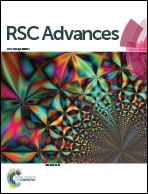Unique interfacial and confined porous morphology of PLA/PS blends in supercritical carbon dioxide
Abstract
In this study, a typical immiscible system, a poly(lactic acid) (PLA)/polystyrene (PS) bioblend is used to investigate the effect of interface and phase structure on bubble nucleation and porous morphologies using supercritical carbon dioxide as a physical foaming agent. A unique microcellular skin-core structure with a porous core and surface, and a nonporous skin layer which is embedded in a solid PLA phase are observed. The involved possible mechanism of the interfacial nucleation and confined foaming behavior in multi-phase systems has been discussed. Because of the higher gas concentration and lower activation energy barrier, bubble nucleation preferentially occurs at the interface of the PS and PLA phases. Due to the constrained effect of the crystalline PLA phase, smaller space could be provided for the expansion of the PS phase during the foaming process, hence gas bubbles in the interior are restrained from further growth. The porous structures of the PS phases are similar when the blends have comparable phase morphology. The results indicated that the confinement effect on the foam behavior is not only related to the crystalline PLA phase but also the phase structure of the blend.


 Please wait while we load your content...
Please wait while we load your content...